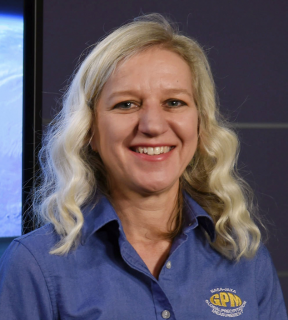
Even though I didn’t know it at the time, my science story starts with that dusting of snow Tallahassee, Florida received when I was about 11 years old. The whole city shut down for a laughable amount of snow. Later when I was in the Electrical Engineering (EE) undergraduate department at Florida State University (FSU), I took an elective class called Disaster Planning for City Managers, and the professor showed the white clouds of a swirling hurricane taken from a satellite. I knew then that I wanted a career in remote sensing of the Earth. Several (ok, many) years later, with an EE Ph.D. in hand of remote sensing of rain, I showed up at NASA GSFC for a post-doc contractor position. My science focus was on estimating the frozen particles above the melting layer in precipitating clouds. Around the time that I became a Civil Servant, that work turned into estimating frozen particles when there is no melting layer (that is estimating falling snow at the Earth’s surface) from satellites. I’ve enjoyed every challenge along the way, you see snowflakes are VERY different than raindrops and that causes all sorts of issues with interpreting the remote sensing observations and converting those into snowfall rates (and indeed with validating the retrievals).
My work, plus that of about 5-10 others, led the Global Precipitation Measurement (GPM) mission to add instrument capabilities to measure falling snow. In 2006, I convinced the GPM Project Scientist (PS) Arthur Hou that my falling snow and engineering skills would make me a good deputy for him. In January 2014, six weeks before GPM’s launch (and seven weeks after Dr. Hou’s tragic passing from pancreatic cancer), I became the PS of GPM.
I am honored, humbled, and thrilled to be the GPM PS. The GPM mission is good for GSFC, scientific observations and is so instrumental for providing scientific benefits for all life on earth. Since water is vital for all life on earth, and precipitation is a key source for our freshwater resources, it is essential to know where, when, and how is precipitation falling, how it will be changing over time, and how might it impact society in terms of water resources, agriculture, disasters (hurricanes, blizzards, floods, and landslides).
Selected Snow Publications (bold highlighted are more key papers than the others):
1. Skofronick-Jackson, G., W. A. Petersen, W. Berg, C. Kidd, E. F. Stocker, D. B. Kirschbaum, R. Kakar, S. A. Braun, G. J. Huffman, T. Iguchi, P. E. Kirstetter, C. Kummerow, R. Meneghini, R. Oki, W. S. Olson, Y. N. Takayabu, K. Furukawa, T. Wilheit, 2017: The Global Precipitation Measurement (GPM) for Science and Society. Bull. Amer. Meteor. Soc., doi:10.1175/BAMS-D-15-00306.1
2. Kidd, C., A. Becker, G. J. Huffman, C. L. Muller, P. Joe, G. Skofronick-Jackson, D. B. Kirschbaum, 2017: So, How Much of the Earth’s Surface Is Covered by Rain Gauges? Bull. Amer. Meteor. Soc., 98, No. 1, 69-78, doi:10.1175/BAMS-D-14-00283.1
3. Johnson, B. T., W. S. Olson, and G. Skofronick-Jackson, 2016: The microwave properties of simulated melting precipitation particles: sensitivity to initial melting. Atmos. Meas. Tech., 9, 9-21, doi:10.5194/amt-9-9-2016.
4. Skofronick-Jackson, G., D. Hudak, W. Petersen, S. W. Nesbitt, V. Chandrasekar, S. Durden, K. J. Gleicher, G.-J. Huang, P. Joe, P. Kollias, K. A. Reed, M. R. Schwaller, R. Stewart, S. Tanelli, A. Tokay, J. R. Wang, and M. Wolde, 2015: Global Precipitation Measurement Cold Season Precipitation Experiment (GCPEx): For Measurement Sake Let it Snow. Bull. Amer. Meteor. Soc., 96, 1719–1741, doi:10.1175/BAMS-D-13-00262.1.
5. Skofronick-Jackson, G. M., B. T. Johnson, S. J. Munchak, 2013: Detection Thresholds of Falling Snow from Satellite-Borne Active and Passive Sensors. IEEE Transactions on Geoscience and Remote Sensing, 51, No. 7, 4177-4189, doi:10.1109/TGRS.2012.2227763.
6. Johnson, B. T., G. W. Petty, and G. Skofronick-Jackson, 2012: Microwave Properties of Ice-Phase Hydrometeors for Radar and Radiometers: Sensitivity to Model Assumptions. J. Appl. Meteor. Climatol., 51, Issue: 12, 2152–2171, doi:10.1175/JAMC-D-11-0138.1.
7. Foster, J. L., G. Skofronick-Jackson, H. Meng, J. R. Wang, G. Riggs, P. J. Kocin, B. T. Johnson, J. Cohen, D. K. Hall, and S. V. Nghiem, 2012: Passive Microwave Remote Sensing of the Historic February 2010 Snow Storms in the Middle Atlantic Region of the U.S. Hydrol. Processes, 26, Issue: 22, 3459-3471, doi:10.1002/hyp.8418.
8. Skofronick-Jackson, G., and B. T. Johnson, 2011: Surface and Atmospheric Contributions to Passive Microwave Brightness Temperatures for Falling Snow Events. J. Geophys. Res., 116, D02213, doi:10.1029/2010JD014438.
9. Skofronick-Jackson, G., A. Heymsfield, E. Holthaus, C. Albers, and M.-J. Kim, 2008: Nonspherical and spherical characterization of ice in Hurricane Erin for wideband passive microwave comparisons. J. Geophys. Res., 113, D6, doi:10.1029/2007JD008866.
10. Kim, M.-J., J. A. Weinman, W. S. Olson, D.-E. Chang, G. Skofronick-Jackson, and J. R. Wang, 2008: A physical model to estimate snowfall over land using AMSU-B observations. J. Geophys. Res., 113, D9, doi:10.1029/2007JD008589.
11. Skofronick-Jackson, G. M., M.-J. Kim, J. A. Weinman, and D.-E. Chang, 2004: A Physical Model to Determine Snowfall over Land by Microwave Radiometry. IEEE Trans. Geosci. Remote Sens., 42, 1047-1058, doi:10.1109/TGRS.2004.825585.

